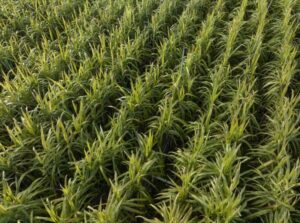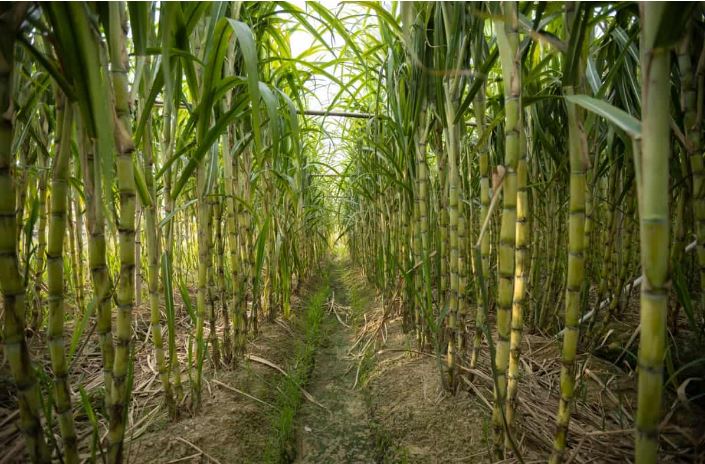Weed Management in Sugarcane Farming: As a sugarcane grower, maintaining a weed-free environment is crucial for optimal crop yield and quality. This guide explores effective strategies to control weeds in sugarcane farming, addressing challenges and ensuring a successful harvest.
Importance of Weed Management
Weeds compete with sugarcane for essential resources like water, light, and nutrients. Chemical weed control using pre-and post-emergence herbicides is common due to field size, requiring cost-effective approaches. Some weeds develop resistance, demanding adaptation in control methods. Selecting suitable genotypes and herbicides is crucial for high yields.
Integrated Weed Management (IWM)
IWM combines cultural, biological, mechanical, and chemical methods for efficient and sustainable weed suppression. Practices like crop rotation and planting high-yielding sugarcane varieties reduce weed infestations. Biological control employs natural enemies, while mechanical techniques physically remove weeds. IWM prevents resistance and minimizes chemical impact.

Chemical Weed Control
Addressing broad-leaved and grassy weeds is essential. A mixture of 2-40 @ 1 kg in 800 liters of water after sowing controls broad-leaved weeds. Grass control involves hand hoeing, spraying Dilapon or Paraquat before sprouting, and applying Atrazine or Simazine after sprouting. Precision ensures weed management while safeguarding crops.
Organic Weed Management
Mulching with organic materials blocks sunlight and intercropping with cover crops competes with weeds. Regular manual weeding and organic herbicides provide selective control. Flame weeding and biological methods play a role in organic sugarcane farming.
Mechanical Weed Control
Tools like kurpi or spades are effective for hoeing fields. Rainy seasons witness rapid growth of weeds like Echinochloa colonum, E. crusgalli, and others. Mechanical weed control enhances soil aeration and can be combined with mixed crop systems.
Pre-emergence Herbicides
“Atrazine” controls grassy and broadleaf weeds, giving sugarcane an edge. “Metribuzin” targets broadleaf weeds. “Diuron” and “S-metolachlor” prevent weed seedling emergence. “Pendimethalin” has broad-spectrum control.
Post-emergence Herbicides
Glyphosate targets a broad spectrum of weeds, while 2,4-D targets broad-leaved varieties. Herbicides like Glufosinate and Sethoxydim have selective action against grasses. Clethodim is effective for grassy weed management.
Selective Herbicides
Selective herbicides like Atrazine and Simazine target specific weeds without harming sugarcane. Metribuzin controls grassy and broad-leaved weeds. Non-selective herbicides like Glyphosate and paraquat provide broad-spectrum control.
Cultural Practices
Dense and healthy sugarcane stands create natural weed barriers. Optimal spacing and irrigation support sugarcane growth. Soil cultivation, crop rotation, and using weed-free sugarcane seeds prevent weed establishment. Efficient harvesting limits weed seed production.
Mulching
Mulching with organic materials conserves soil moisture, regulates temperature, and prevents erosion. It acts as a physical barrier to weed growth.
Biological Control
Using weed-eating insects and beneficial microbes suppresses weed growth. Cover crops outcompete weeds for resources.
Crop Rotation
Alternating sugarcane cultivation with other crops disrupts weed growth, reducing the weed seed bank in the soil.
Weed Identification and Monitoring
Regular field surveys and categorizing weeds based on growth patterns are crucial. Monitoring techniques assess weed density and distribution.
Herbicide Resistance Management
Rotating herbicides, using cultural practices, and incorporating mechanical control prevent herbicide resistance.
Sustainable Weed Management
Implementing effective weed management practices is essential for long-term sugarcane cultivation. Balancing organic, chemical, and cultural approaches ensures a successful harvest.
Weed Management in Ratoon Sugarcane Planting
Early 30-60 days are crucial for weed control. Cultural and mechanical methods like initial plowing, off-barring, and trash mulching are effective.
Incorporating herbicides like Atrazine or Glyphosate after ratoon initiation provides weed-free conditions. Combining herbicide use with manual weeding at 60 DAP yields the best results.
These comprehensive strategies encompass organic, chemical, and cultural practices, enabling sugarcane farmers to effectively control weeds, ensure sustainable farming, and optimize crop productivity.


